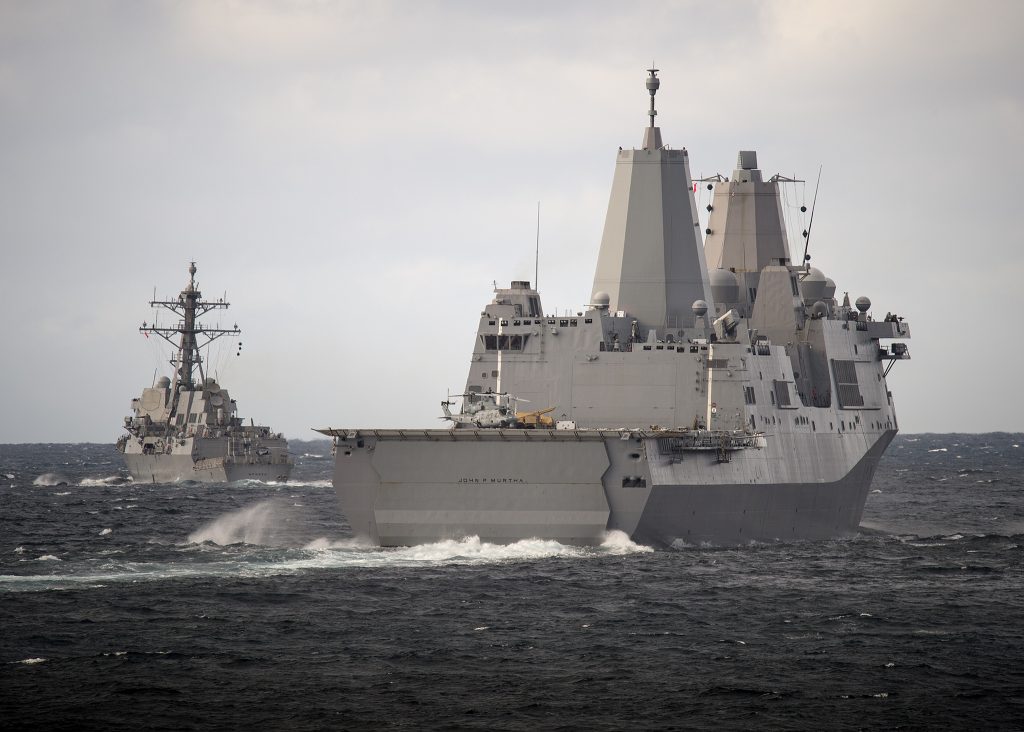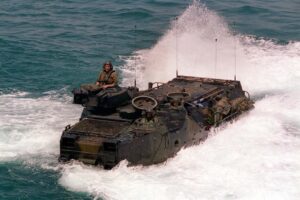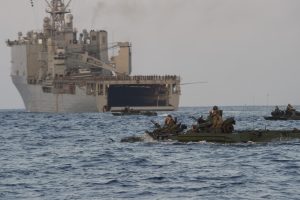
Amphibious dock landing ship USS John P. Murtha and destroyer USS Momsen in the eastern Pacific.
WASHINGTON: Wary of bringing big, expensive warships full of sailors and Marines in missile range of hostile coastlines, the Pentagon plans to cut two new amphibious warships out of the 2020-2024 budget plan to be released later this month, defense officials confirmed.
The decision to delay the planned purchase of two San Antonio-class Flight II landing dock ships, known as LPDs, out past 2024 is part of a much wider reevaluation of naval warfare. Under high-level pressure to build a fleet better able to face Chinese and Russian precision missiles, the Navy is reducing its investment in large but potentially warships like amphibs and carriers so it can free up money for more offensive weaponry on smaller surface ships, submarines, and aircraft.
The Navy is set to make the request in its fiscal 2020 budget set to be delivered to Congress on March 12, which will also include a controversial plan to cut the mid-life refueling of the USS Harry S. Truman aircraft carrier, essentially retiring the flattop two decades early.
The current LPDs can carry several hundred Marines who can climb down to the well deck, open to the water, to embark on aging amphibious vehicles, or climb up to the flight deck and board helicopters or tilt-rotors to race to a disaster zone, hostage rescue, or raid target.

The Marine Corps Amphibious Assault Vehicle.
According to Marine Corps leadership, the ships as they’re currently constituted will have difficulty in a future where the US will have to “fight to get to the fight,” as Lt. Gen. David Berger, the head of the Corps’ combat development office, said recently at an Amphibious Warship Industrial Base Coalition breakfast on Capitol Hill.
But moving the build of the new “Flight II” variant of the ships — which promises to cut costs in some areas while upgrading radar, among other improvements — into the future would likely make that mission even harder, while calling the overall amphibious mission into question. If the plan makes it though Congress, it would likely also delay the Navy’s ability to reach its goal of 38 amphibious ships from the current 32.
“The fact that the Navy wants to push a couple of these past the FYDP [the 5-year Future Year Defense Plan] is not a good sign,” said Dakota Wood, a former Marine officer now at the Heritage Foundation. “They’re not going to be ready to come into the fleet to offset to loss of current capabilities” as older ships retire, which will mean a loss of training opportunities for Marines and operational assets for commanders.

Marines near the Whidbey Island-class amphibious dock landing ship USS Germantown.
The proposed pushback of the Flight II LPDs would also likely effect the refit of the aging Whidbey Island-class dock landing ships, currently scheduled to be replaced by the Flight IIs beginning in the 2020s.
Gen. Berger said that he has been pushing for “accelerating buys and looking at two-ship buys” for the Flight II ships so the Navy can spend on buying new, modern ships instead of keeping older hulls in operation. “Flight II procurement cannot be pushed out into the future,” he said. “There’s an industrial capacity portion of that, but frankly, selfishly, there’s a warfighting part that says we can’t take a hiatus for two or three years. We cannot do that. It’s too important.”
But Bryan Clark, a retired naval officer and analyst at the Center for Strategic and Budgetary Assessments, said the deferment of the Flight II makes sense from a strategic and budgetary perspective.
“This is going to be a strategy-driven budget, and here’s where you see the strategy coming though,” he said. The imperative to increase “lethality” — hammered home by then-Defense Secretary Jim Mattis and picked up by acting SecDef Patrick Shanahan — in many ways supports moving some LPD money into more deadly surface combatants that can both defend themselves and strike distant enemies.
But, Clark added, “the Navy is doing these things driven by strategy — with knowledge that Congress will likely want to put them back in and add more money.” Even if that doesn’t happen, with budgets being finite, the Navy appears to have made a decision to “press hard on the undersea and surface combatant force, and take reductions in the part of the force that needs to make some changes in order to contribute to the strategy.”
One thing that may have worked against the Flight II ships is the fact they’re being contracted on a one-by-one basis, as opposed to the block buys the Navy has recently undertaken on the Ford-class carriers, Virginia -class submarines, and the Littoral Combat Ships, among other programs. Those block buys offer the Navy savings in return for committing itself to years of purchases, so shipbuilders can start planning and buying material years before construction begins. Without a similar contractual lock-in, the Flight IIs are easier to defer, simply because the up-front investments have been smaller.
But those investments still matter immensely to thousands of voters. Retired Adm. Terry McKnight, chairman of the Amphibious Warship Industrial Base Coalition, told me Thursday that the amphibious warship industrial base includes more than 850 companies spread across 250 congressional districts — something the Navy and Congress both well know.
Last year, Congress boosted the Navy’s shipbuilding account by $2.2 billion, a 10 percent increase over the $21.9 billion originally requested. A not insignificant $350 million of that was earmarked for the accelerated acquisition of the LPD-17 Flight II. The Hill clearly is interested in the ship. That interest will be tested next month, after the 2020 budget drops on Capitol Hill.
Sydney Freedberg contributed to this article.
GD chief says Navy’s 1 sub buy won’t impact company short term, but out years less certain
The comments from the General Dynamics chief come on the same day President Joe Biden signed the national security supplemental, which includes billions for the sub industrial base.



























